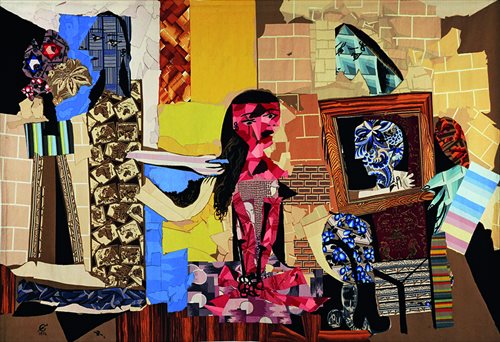

Tapestries Women at Their Toilet, Berlin B, and Map of Truths and Beliefs displayed at the Power Station of Art
Faced with hundreds of tapestries and carpets from China and abroad exhibited at the Power Station of Art, Shi Hui, director of the Research Center of Tapestry at China Academy of Art in Hangzhou, Zhejiang Province, found her thoughts drawn to the year 1987.
The first institution in China to teach and create contemporary fabric artworks, the Research Center of Tapestry, founded by Bulgarian artist Marin Varban Ivanov in 1986, organized an exhibition at Shanghai Exhibition Center in 1987 and introduced to local audiences contemporary tapestry art. Meanwhile, the Lausanne International Tapestry Biennial in Switzerland received and exhibited Chinese tapestries for the first time that same year.
"The year inevitably marked the beginning of the development of China's contemporary tapestry art," remarked Shi, noting that since then tapestry art in China is no longer solely regarded as craftwork but has been widely received as an art form in itself and a significant part of the contemporary art scene.
Shi is also one of the artists featured at the ongoing exhibition, entitled Decorum: Carpets and Tapestries by Artists, which is co-organized by Power Station of Art and the Modern Art Museum of Paris. It will display more than 100 tapestries and carpets from Asia, Africa and Europe until July 13.
The exhibits range from textiles from the 6th century to artistic installations made by contemporary artists, and from tapestries that recreate Western abstract and conceptual masterpieces to carpets that embody China's minority groups.
In collaboration with Chinese artist Zhu Wei, Shi presented at the exhibition a giant tapestry installation named Longevity, which uses wool, hemp and silk to weave the Chinese character for "longevity" against a tapestry shaped in a tortoise shell with inscriptions. The tortoise in Chinese culture also represents longevity.
Visitors can also see a tapestry version of Pablo Picasso's Women at Their Toilet made by Gobelins Manufacture in France in 1976 and 1977, which was completed in accordance with the original and has retained the abstract spirit of the master. Meanwhile, Berlin B by American multimedia artist Pae White is a tapestry whose woven patterns of floating smog can rival a high resolution photograph. English artist Grayson Perry's Map of Truths and Beliefs that was woven by Flanders Tapestries according to digitalized versions of the artist's sketches.
"The 1960s and 1970s saw a reform in tapestry art in Europe as artists began to participate in the weaving process of their works and tapestries and carpets were no longer merely for decoration but also for personal expression," said Shi.
Anne Dressen, a curator at the Modern Art Museum of Paris, said at the opening ceremony of the exhibition that the show aims to underline the relations between art and crafts and the influence of carpets and tapestries on the art of the 20th century.
"The influence is crucial, yet overlooked," said Dressen, who believes primitive textiles as well as medieval tapestry has exerted great influence on abstract and conceptual art.
The exhibition was held at the Paris venue from last October to February. The Shanghai exhibition is three times larger than the French one, with the participation of more Chinese artists and ancient artworks. Meanwhile, the exhibition also showcases some sound art projects by French and Chinese artists.
Date: Until July 13, 9 am to 5 pm (closed on Mondays)
Venue: 1/F and 2/F, Power Station of Art
Address: 200 Huayuangang Road
Admission: 20 yuan
Call 3110-8550 for details
Copyright ©1999-2018
Chinanews.com. All rights reserved.
Reproduction in whole or in part without permission is prohibited.